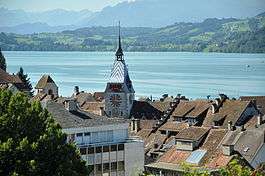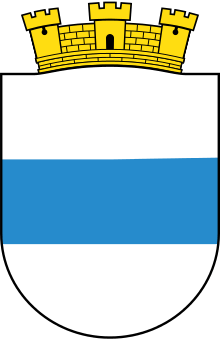Zug
| Zug | ||
|---|---|---|
|
View over Lake Zug with the old town of Zug and the Zytturm | ||
| ||
 Zug | ||
|
Location of Zug 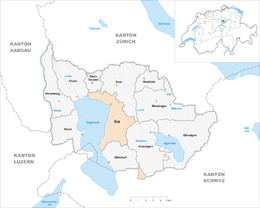 | ||
| Coordinates: 47°10′N 8°31′E / 47.167°N 8.517°ECoordinates: 47°10′N 8°31′E / 47.167°N 8.517°E | ||
| Country | Switzerland | |
| Canton | Zug | |
| District | n.a. | |
| Government | ||
| • Executive |
Stadtrat with 5 members | |
| • Mayor |
Stadtpräsident (list) Dolfi Müller SPS/PSS (as of December 2015, since 2007) | |
| • Parliament |
Grosser Gemeinderat with 40 members , instaured 1963) | |
| Area[1] | ||
| • Total | 21.61 km2 (8.34 sq mi) | |
| Elevation (Landsgemeindeplatz) | 425 m (1,394 ft) | |
| Highest elevation (Zugerberg) | 1,039 m (3,409 ft) | |
| Lowest elevation (Sumpf (Dorfbach)) | 415 m (1,362 ft) | |
| Population (Dec 2015[2]) | ||
| • Total | 29,256 | |
| • Density | 1,400/km2 (3,500/sq mi) | |
| Demonym(s) | German: Zuger/Zugerin | |
| Postal code | 6300 | |
| SFOS number | 1711 | |
| Surrounded by | Cham, Baar, Walchwil, Steinhausen | |
| Twin towns | Fürstenfeld (Austria) | |
| Website |
www SFSO statistics | |
Zug (German: Zug, [tsuːɡ]; French: Zoug; Italian: Zugo; Romansh: Zug; Neo-Latin Tugium[Note 1]), is a municipality and a town in Switzerland. The name Zug originates from fishing vocabulary; in the Middle Ages it referred to the right to pull up fishing nets and hence to the right to fish.
The town of Zug is located in the canton of Zug and is the canton's capital. As of 31 December 2015 it had a total population of 29,256 inhabitants.[3]
The official language of Zug is (the Swiss variety of Standard) German, but the main spoken language is the local variant of the Alemannic Swiss German dialect.
History
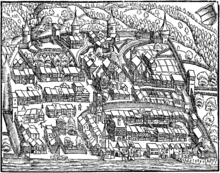

Prehistory
The oldest human traces date back to the time of around 14,000 BC. There have been Paleolithic finds on the north bank of Lake Zug, which come from nomadic hunters and gatherers. Archaeologists have also been able to prove the existence of over forty lake-shore settlements (pile dwellings), on the shores of Lake Zug, from the epoch of the first settled farmers in the Neolithic period (5,500-2,200 BC). The peak in these lake-shore village settlements was in the period between 3800 and 2450 BC. For the same epoch, the first pre-alpine land use has been proven in Menzingen and in the Ägeri valley. The well-known, historically-researched and interesting lake-shore village, ‘Sumpf’ (the swamp), dated from the late Bronze Age (up until 850 BC). These rich finds result in a quite differentiated picture of life in former times, attractively represented in the Zug Museum for Prehistory. In addition, many traces from the Iron Age (850-50 BC) and the Roman and Celtic-Roman time (from 50 BC) have been discovered.
Kyburg foundation
In around AD 600, Alemannic families and tribes immigrated to the area of present-day canton Zug. The name Blickensdorf, and place names with ‘- ikon’ endings, prove this as the first Alemannic living space. The churches of Baar and Risch also date back to the early Middle Ages. The first written document on the area originates from the year 858, and refers to King Ludwig the German giving the farm Chama (Cham) to the Zürich Fraumünster convent. At this time, the area of present-day Zug belonged to completely different monastic and secular landlords, the most important of whom were the Habsburgs, and who, in 1264, inherited the Kyburg rights and remained a central political power until about 1400.
In the course of the high medieval town construction, the settlement of Zug also received a town wall at some point after 1200. The town founders were probably the counts of Kyburg. The town, first mentioned in AD 1240, was called an "oppidum" in 1242 and a "castrum" in 1255. In 1273, it was bought by Rudolph of Habsburg from Anna, the heiress of Kyburg and wife of Eberhard, head of the cadet line of Habsburg.[4] Through this purchase it passed into the control of the Habsburgs and was placed under a Habsburg bailiff. The Aeusser Amt or Outer District consisted of the villages and towns surrounding Zug, which each had their own Landsgemeinden but were ruled by a single Habsburg bailiff. Zug was important as an administrative center of the Kyburg and the Habsburg district, then as a local market place, and, thereafter, as a stage town for the transport of goods (particularly salt and iron) over the Hirzel hill towards Lucerne.
Joining the Swiss Confederation
On 27 June 1352, both the town of Zug and the Aeusser Amt entered the Swiss Confederation, the latter being received on exactly the same terms as the town, and not, as was usual in the case of outer districts, as a subject land; but in September 1352, Zug had to acknowledge its own lords again, and in 1355 was obliged to break off its connection with the league. About 1364, the town and the Aeusser Amt were recovered for the league by the men of Schwyz, and from this time Zug took part as a full member in all the acts of the league. In 1379, the Holy Roman Emperor Wenceslaus exempted Zug from all external jurisdictions, and in 1389 the Habsburgs renounced their claims, reserving only an annual payment of 20 silver marks, which came to an end in 1415. In 1400 Wenceslaus gave all criminal jurisdiction to the town only. The Aeusser Amt, in 1404, then claimed that the banner and seal of Zug should be kept in one of the country districts and were supported in this claim by Schwyz. The matter was finally settled in 1412 by arbitration, and the banner was to be kept in the town. Finally in 1415, the right of electing their landammann was given to Zug by the Confederation, and a share in the criminal jurisdiction was granted to the Aeusser Amt by German king Sigismund.[4]
The alliance of the four forest cantons of Uri, Schwyz, Unterwalden and Lucerne with the city of Zürich in 1351 set much in motion. The town of Zug was seen as having Habsburg ties with the cities of Zürich and Lucerne, and therefore had to be conquered. It is likely that this was more for political than economic reasons: the Lucerne market was very important for central Switzerland, but also strongly dependent on the city of Zürich. Zürich initiated a siege on Zug with the federal army in June 1352. Zug surrendered. On 27 June 1352 Zürich, Luzern, Zug, Uri, Schwyz and Unterwalden formed an alliance. Zürich's saw this ‘Zugerbund’ (Zug alliance) as an alliance of convenience. For the town of Zug, little changed, and Zug remained Habsburg. That same year, the Zug alliance was declared invalid by all parties. A period of Schwyz domination then followed. Only gradually did Zug become sovereign and federal.
Simultaneously, Zug expanded its territory, acquiring a number of rural areas in the form of bailiwicks (Walchwil, Cham, Gangolfswil [Risch] Hünenberg and Steinhausen, and Oberrüti, now part of the canton of Aargau). Zug became a confederation in itself - with the town and its subject territories, and the three outer (‘free’) municipalities, Ägeri, Menzingen (with Neuheim) and Baar. This problematic dualism dominated until 1798, i.e. until the end of the old confederation, the political structure of the Canton Zug. The unifying element of this miniature confederation was, among others, the rural municipalities and the forty-member city council.
Growth of the town
In 1385, Zug joined the league of the Swabian cities against Leopold III of Austria and shared in the victory of Sempach, as well as in the various Argovian (1415) and Thurgovian (1460) conquests of the Confederates, and later in those of Italy (1512), having already taken part in the occupation of the Val d'Ossola. Between 1379 (Walchwil) and 1477 (Cham), Zug had acquired various districts in its own neighborhood, principally to the north and the west, which were ruled till 1798 by the town alone as subject lands.[4]
In 1478, the building of a larger town wall began, which increased the town area six-fold - the same year as the building of the late gothic St. Oswald Church began. The building master of the new town wall was Hans Felder from Bavarian Swabia. The ground plan of the town wall is indicative of an ideal symmetric plan of the Renaissance period – something very rare at that time. The overall urban planning implemented in the small town of Zug was modern for its time.
The Reformation and Early Modern Era
During the turmoil of the Reformation, Zug remained on the Catholic side of central Switzerland and retained the old faith. Warring religious confederates fought at Kappel am Albis (1531) and at Gubel in Menzingen. Its location on the edge of central Switzerland made Zug a confessional border town. During the Reformation, Zug clung to the old faith and was a member of the Christliche Vereinigung of 1529. In 1586, it became a member of the Golden League.[4]
The period up until 1798 was marked by internal political rivalries and turbulence. The invasion of the French troops marked the end of the old order, and with the Helvetic order came a radical political change. Zug became part of the canton Waldstätten, and the cantonal capital for a short time. After a 50-year struggle between federalism and centralism, between confederation and central state, between conservative and liberal-radical vision, in 1848, today’s federal government of Switzerland emerged. Zug was given its current cantonal structure, consisting of eleven local municipalities.
Industrialization and internationalization
Until well into the 19th century, Zug consisted of agricultural land. Actual industrialization began with the entrepreneur Wolfgang Henggeler, who in 1834 built a cotton mill in Unterägeri. This was followed by the two companies in Neuägeri and Baar. In 1866, the American George Ham Page founded the first European condensed milk factory in Cham, which later merged with Nestlé. Industry in Zug was dominated by the company Landis+Gyr, founded in 1896, and now owned by Toshiba. The connection to the Swiss railway network in 1864 was important, as was the connection of mountain and valley with an electric tram at the beginning of the 20th century.
In the second half of the century, dynamic expansion took place and Zug became a national and international financial and trading center, aided by its proximity to Zürich, and by an attractive tax policy. In parallel, large industrial and commercial zones evolved; employment increased rapidly; the population rose sharply, and the building boom skyrocketed. Canton Zug catapulted itself into being at the top of the financially strong cantons. And the town today has become, as the British Guardian once wrote, ‘a compass of the global economy’.
Today
Zug is a low tax region, and is headquarters for a number of multinational enterprises.
Zug's best known agricultural product is Kirsch.
On 27 September 2001, an angry, unstable gunman, Friedrich Leibacher, shot and killed 15 people including himself in the cantonal parliament of Zug. The event became known as the Zug Massacre.[5]

Geography
Topography
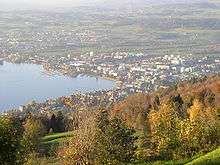
The municipality Zug has an area of 33.84 square kilometers (13.07 sq mi). Of this area, 35.5% is used for agricultural purposes, while 38.1% is forested. Of the rest of the land, 23.8% is settled (buildings or roads) and the remainder (2.6%) is non-productive (rivers, lakes or mountains).[6]
Climate
| Climate data for Zug | |||||||||||||
|---|---|---|---|---|---|---|---|---|---|---|---|---|---|
| Month | Jan | Feb | Mar | Apr | May | Jun | Jul | Aug | Sep | Oct | Nov | Dec | Year |
| Average high °C (°F) | 5 (41) |
5 (41) |
10 (50) |
14 (57) |
17 (63) |
20 (68) |
23 (73) |
23 (73) |
19 (66) |
16 (61) |
10 (50) |
5 (41) |
13.9 (57) |
| Average low °C (°F) | −2 (28) |
−2 (28) |
0 (32) |
3 (37) |
6 (43) |
9 (48) |
12 (54) |
12 (54) |
9 (48) |
6 (43) |
2 (36) |
−1 (30) |
4.5 (40.1) |
| Average precipitation days (≥ 1.0 mm) | 12.3 | 11.5 | 13 | 11.3 | 11.3 | 11.3 | 11.5 | 10.1 | 9.4 | 9.6 | 11.5 | 13.1 | 135.9 |
| Average snowy days (≥ 1.0 cm) | 4.1 | 4.2 | 1 | 0.7 | 0.1 | 0 | 0 | 0 | 0 | 0.1 | 1.7 | 3.9 | 15.8 |
| Source: Meteoblue[7] | |||||||||||||
See also climate of Lucerne and Zürich.
Weather
Zug has an average of 136.1 days of rain per year and on average receives 1,224 mm (48.2 in) of precipitation. The wettest month is August during which time Zug receives an average of 158 mm (6.2 in) of precipitation. During this month there is precipitation for an average of 12.7 days. The month with the most days of precipitation is June, with an average of 13.7, but with only 156 mm (6.1 in) of precipitation. The driest month of the year is January with an average of 67 mm (2.6 in) of precipitation over 12.7 days.[8]
Politics
Government
The City Council (Stadtrat) constitutes the executive government of the Town of Zug and operates as a collegiate authority. It is composed of five councilors (German: Stadtrat/-rätin), each presiding over a department (Departement) comprising several bureaus. The president of the executive department acts as mayor (Stadtpräsident). In the mandate period 2015–2018 (Legislatur) the City Council is presided by Stadtpräsident Dolfi Müller. Departmental tasks, coordination measures and implementation of laws decreed by the City Parliament are carried by the City Council. The regular election of the City Council by any inhabitant valid to vote is held every four years. The current mandate period (Legislatur) is from 2015 to 2018. Any resident of Zug allowed to vote can be elected as a member of the City Council. The delegates are selected by means of a system of Majorz (since 2014). The mayor is elected as such as well by public election while the heads of the other departments are assigned by the collegiate. The executive body holds its meetings in the Stadthaus (City Hall) on Kolinplatz.[9]
As of 2015, Zug's City Council is made up of one each of SP (Social Democratic Party, who is also the mayor), CVP (Christian Democratic Party), CSP (Christian Social Party), FDP (FDP.The Liberals), and SVP (Swiss People's Party). The last regular election was held on 5 October 2014.[10]
| City Councilor (Stadtrat/-rätin) | Party | Head of Department (Vorsteher, since) of | elected since |
|---|---|---|---|
| Dolfi Müller[SR 1] | SP | Mayor's Office (Präsidialdepartement, 2007) | 2002 |
| Karl Kobelt | FDP | Finance (Finanzdepartement, 2013) | 2013 |
| Vroni Straub-Müller | CSP | Education (Bildungsdepartement, 2011) | 2010 |
| André Wicky[SR 2] | SVP | Engineering (Baudepertement, 2011) | 2010 |
| Urs Raschle | CVP | Social Welfare, Environment, and Security (Departement Soziales, Umwelt und Sicherheit (SUS), 2015) | 2014 |
Martin Würmli is Town Chronicler (Stadtschreiber) since 2014 and presides the Town Office (Stadtkanzlei). He has been elected by the collegiate.
Federal elections
National Council
In the 2015 federal election the most popular party was the SVP with 25.4% of the vote. The next three most popular parties were the CVP (22.5%), the FDP (19.5%) and the SP (17.2%). In the federal election, a total of 9,438 votes were cast, and the voter turnout was 55.4%. The 2015 election saw a large change in the voting when compared to 2011. The percentage of the vote received by the SP increased sharply from 6.4% in 2011 to 17.2% in 2015, while the percentage that the GPS received dropped from 21.3% to 9.5%.[11]
International relations
Twin and sister cities
After World War II, Zug help the dishonored town of Fürstenfeld, Styria in Austria. In 1986 they decided to become sister cities.[12]
Demographics

Zug has a population (as of 31 December 2015) of 29,256.[13] As of 2014, 31.7% of the population was made up of foreign nationals.[14] Over the last 10 years the population has grown at a rate of 11.4%. Most of the population (as of 2000) speaks German (81.8%), with Italian being second most common (3.8%) and Serbo-Croatian being third (3.2%).[6]
In Zug about 76% of the population (between age 25-64) have completed either non-mandatory upper secondary education or additional higher education (either university or a Fachhochschule).[6]
Zug has an unemployment rate of 2.28%. As of 2005, there were 172 people employed in the primary economic sector and about 51 businesses involved in this sector. 5,821 people are employed in the secondary sector and there are 269 businesses in this sector. 21,445 people are employed in the tertiary sector, with 3,205 businesses in this sector.[6]
Sport
The main sport team is the EV Zug, which plays in the National League A (NLA). They play their home games at the Bossard Arena. Their affiliate team, the EV Zug Academy, which competes in the National League B (NLB), also plays in the Bossard Arena.
There are also an association football team, Zug 94, which was formed in 1994 and two Rugby Teams, the Rugby Club Zug, which has a junior team, The Saints Rugby School and the Rugby Bombers Zug, which was founded by former members of the Rugby Club Zug. Additionally there is a floorball team, it's called Zug United.
Economy
As of 2012, there were a total of 40,166 people employed in the municipality. Of these, a total of 142 people worked in 42 businesses in the primary economic sector. The secondary sector employed 5,939 workers in 351 separate businesses. Finally, the tertiary sector provided 34,085 jobs in 6,592 businesses. In 2013 a total of 15.3% of the population received social assistance.[15]
In July 2016, the city of Zug began to accept digital currency in payment of city fees. In order to advance Zug as a region that is innovating with future technologies, the city council added bitcoin as a means of paying small amounts, up to SFr 200. In order to reduce risk, Zug immediately converts any bitcoin received into the Swiss currency.[16]
Culture



Situation
The lake shore has been embanked and forms a promenade, from which glorious views of the Rigi and Pilatus, as well as of the snowy peaks of the Bernese Oberland, are gained. Towards its northerly end, a monument marks the spot where a part of the shore slipped into the lake in 1887.
The older part of the town is rather crowded together, though only four of the wall towers and a small part of the town walls still survive.
The most striking old building in the town is the parish church of St Oswald (late 15th century), dedicated to St Oswald, king of Northumbria (d. 642), one of whose arms was brought to Zug in 1485. The town hall, also a 15th-century building, now houses the Historical and Antiquarian Museum. There are some quaint old painted houses close by. A little way higher up the hillside is a Capuchin convent in a striking position, close to the town wall and leaning against it. Still higher, and outside the old town, is the fine new parish church of St Michael, consecrated in 1902.
The business quarter is on the rising ground north of the old town, near the railway station. Several fine modern buildings rise on or close to the shore in the town and to its south, whilst to the southwest is a convent of Capuchin nuns, who manage a large girls' school and several other educational establishments.
The Museum of Prehistory Zug houses an important collection of archaeological remains, especially from the late Bronze Age (urnfield culture) settlement of Zug-Sumpf. Many of Catharine II of Russia's relatives descended from Zug and became known as the Volga Germans.
Museums
There are three museums in the town: the Museum of Prehistory, which displays archaeological finds from Canton Zug; the castle houses the Museum of Cultural History of the town and Canton Zug, and the Zug Art Gallery attracts visitors with its exhibitions.[17] Several municipalities also have their own local museum. The Casino Theatre in Zug and the Zug Burgbachkeller, along with the Chollerhalle cultural center, are the most famous establishments. The event centers in Baar, Cham and Rotkreuz and the Zug youth scene (Galvanik, Podium Industrie 45) enrich the range of cultural events.
Zug is surrounded with mountains, rivers and lakes including the mountains Zugerberg and the Walchwilerberg Oberallmig, the Höhronen and the river Sihl. The Choller nature reserve is also near Lake Zug.
Sights with in the town include the late Gothic church of St. Wolfgang, near Hühnenberg, or St. Oswald in Zug, the old town of Zug with the Town Hall and the Clock tower, the Huwiler Tower, the Zurlaubenhof, feudal estate of the family Zurlauben, on the outskirts of the town.
Zug’s culture also includes the famous Zuger cherry liqueur cake. Local specialties, in addition to the cherry and the cherry liqueur cake, include the Zug ‘Rötel’, a fine lake charfish, found on many menus.[18]
The IG Culture Zug society currently has some 200 members.
Heritage sites
There are a number of Swiss heritage sites of national significance in Zug. These include two libraries, the Library of the former Capuchin monastery and the library of the parish church of St. Michael. One archeological site, the Sumpf a late Bronze Age lake shore settlement, is included, as are three museums; the Burg (Castle museum), Kunsthaus (Art museum) and Museum für Urgeschichte (Museum for ancient history). There are three archives that are included in the list; Bürgerarchiv Zug (Citizen's archive of Zug), Staatsarchiv Zug (State/Canton of Zug archive) and the Unternehmensarchiv der Landis & Gyr AG (Landis & Gyr AG company archives). The rest of the sites are the Catholic Church of St. Oswald with Charnel house, the Seminary of St. Michael, the town walls and several buildings in the old town of Zug.[19]
The prehistoric settlements at Oterswil/Insel Eielen, Riedmatt and Sumpf are part of the Prehistoric Pile dwellings around the Alps a UNESCO World Heritage Site.[20]
Education
The Zug education system is based on equal abilities and includes compulsory primary and secondary school, with optional secondary education and vocational training. Two thirds of young people go into vocational education, connected to an apprenticeship, joining the professional world after the 9th grade of secondary school. The international business community of Zug offers many and varied apprenticeships along with the Zug technical and industrial college, GIBZ, and the business college, KBZ, provide the academic knowledge and skills.
Zug has a long tradition of education. Private schools, like the Montana Institute Zug, on Zugerberg, or the Dr. Pfister Institute AG, Oberägeri supplement the range available. In addition, there are the three former non-state teacher training colleges in Menzingen, Holy Cross in Cham and St. Michael in Zug.
Tertiary education
Canton Zug has two high schools: the Canton High School in the town of Zug, and the Cantonal School in Menzingen. Also at higher secondary level, is the Vocational School Zug and the Business Studies School, incorporated within the Canton School. Zug is one of the university cantons, with, on the one hand, the University of Teacher Training, PHZ Zug, on the other, a polytechnic for financial services.
There are also six technical colleges (for business, computer science, engineering design, naturopathy and homeopathy, child education, and rescue services).
International Schools
The range of educational institutions is a key factor for location in the globalized world of competition, especially for foreign employees, the so-called ‘Expats’. The four international schools have been developed accordingly, and report a high student intake. 1300 children from more than 50 countries attend the International School of Zug and Luzern alone, at its two campuses in Hünenberg and Baar.
Transportation
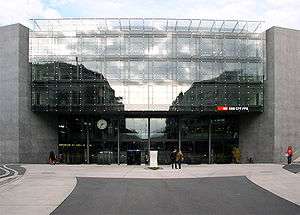
Zug acts as an important transportation node.
An extensive bus network within the town and canton is provided by ZVB Zugerland Verkehrsbetriebe.[21]
The Swiss Federal Railways link at Zug railway station for Cham - Horgen - Zürich, Steinhausen - Affoltern am Albis, Arth-Goldau - St. Gotthard - Ticino and Italy, and Rotkreuz - Luzern. Zug is the hub of the Zug Stadtbahn (an S-Bahn-style commuter rail network) and is also a terminal station of the Zürich S-Bahn on the lines S9 and S21.
The Zugerbergbahn, a funicular, links the Zug suburb of Schönegg (558m) with the Vordergeissboden (literally: anterior goat terrain, 925m), the plateau of the Zugerberg overlooking the town and Lake Zug.
The A4 motorway and other main roads connect Zug with the rest of the nation.
Water transportation has its node on Lake Zug at Zug.
Notes and References
Notes
- ↑ named in the 16th century
References
- ↑ Arealstatistik Standard - Gemeindedaten nach 4 Hauptbereichen
- ↑ Swiss Federal Statistical Office - STAT-TAB, online database – Ständige und nichtständige Wohnbevölkerung nach institutionellen Gliederungen, Geburtsort und Staatsangehörigkeit (German) accessed 30 August 2016
- ↑ Swiss Federal Statistical Office - STAT-TAB, online database – Ständige und nichtständige Wohnbevölkerung nach institutionellen Gliederungen, Geburtsort und Staatsangehörigkeit (German) accessed 30 August 2016
- 1 2 3 4 Coolidge 1911, p. 1048.
- ↑ Untersuchungsrichterlicher Schlußbericht (German)
- 1 2 3 4 Swiss Federal Statistical Office accessed 22-Sep-2009
- ↑ "Klima Zug". Basel (Oder), Switzerland: Meteoblue. Retrieved 2015-12-26.
- ↑ "Temperature and Precipitation Average Values-Table, 1961-1990" (in German, French, and Italian). Federal Office of Meteorology and Climatology - MeteoSwiss. Retrieved 8 May 2009., the weather station elevation is 435 meters above sea level.
- 1 2 "Stadtrat" (official site) (in German). Zug, Switzerland: Town Zug. 2015. Retrieved 2015-12-26.
- ↑ "Stadt Zug" (in German). Kanzlei, Kanton Zug. 7 October 2014. Retrieved 2015-12-26.
- ↑ Swiss Federal Statistical Office - Nationalratswahlen 2015: Stärke der Parteien und Wahlbeteiligung nach Gemeinden (German) accessed 18 July 2016
- ↑ "Fürstenfeld - die Schwesterstadt von Zug" (in German). Zug, Switzerland: Town Zug. Retrieved 2015-12-26.
- ↑ Swiss Federal Statistical Office - STAT-TAB, online database – Ständige und nichtständige Wohnbevölkerung nach institutionellen Gliederungen, Geburtsort und Staatsangehörigkeit (German) accessed 30 August 2016
- ↑ "Ständige Wohnbevölkerung in den Zuger Gemeinden, 2010-2014, nach Staatsangehörigkeit" (XLS) (statistics) (in German). Fachstelle für Statistik, Amt für Raumplanung, Kanton Zug. 2015. Retrieved 2015-12-27.
- ↑ Swiss Federal Statistical Office - Regional portraits accessed 2 May 2016
- ↑ Uhlig/jse, Christian (2016-07-01). "Alpine 'Crypto Valley' pays with Bitcoins". DW Finance. Retrieved 2016-07-18.
- ↑ Museums of Zug
- ↑ Zug Tourism
- ↑ Swiss inventory of cultural property of national and regional significance Archived 1 May 2009 at the Wayback Machine. 21.11.2008 version, (German) accessed 22-Sep-2009
- ↑ UNESCO World Heritage Site - Prehistoric Pile dwellings around the Alps
- ↑ "Zugerland Verkehrsbetriebe". Zug Town. Retrieved 2015-12-26.
External links
| Wikimedia Commons has media related to Zug. |
- Official town website (German)
- ZVB Zugerland Verkehrsbetriebe
- Pictures Zug
- Pictures and history Zytturm (German) (klick "english" and "clocktower")
